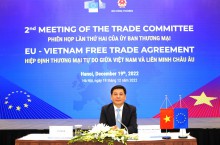The News
Overview of the Vietnam - Chile Free Trade Agreement (VCFTA)
With 14 chapters including 104 Articles and 8 annexes, VCFTA deals only with the aspects of goods, such as provisions on market access facilitation, rules of origin, SPS, TBT, trade remedies...
With 14 chapters including 104 Articles and 8 annexes, VCFTA deals only with the aspects of goods, such as provisions on market access facilitation, rules of origin, SPS, TBT, trade remedies...
1. VCFTA key commitments
The Vietnam - Chile Free Trade Agreement (VCFTA) was negotiated in October 2008 and signed on 11/11/2011 in Hawaii, the U.S. However, due to the internal ratification procedures of each country, the VCFTA Agreement took effect on January 1, 2014.
With 14 chapters including 104 Articles and 8 annexes, VCFTA deals only with the aspects of goods, such as provisions on market access facilitation, rules of origin, SPS, TBT, trade remedies...
According to the Agreement, Vietnam commits to eliminate 87.8% of specific tariff lines which accounts for 91.22% of import turnover from Chile in 2007. In 15 following years, supposingly by 2029 as final schedule, the number of non – or partially - committed cut tariff lines by Vietnam will be 12.2%, focusing on a number of sensitive products such as agriculture, petroleum, etc.
Vietnam commits to eliminate another 1163 lines by 2023, that make the total number of 0% tariffs to 3860, equivalent to 42.42% of the table. The speed of tariffs elimination in the VCFTA Agreement is committed to be accelarated in the last 5 years of the Agreement, to reach the maximum committed rate of 87.8% by 2028.

Groups of products that Vietnam commits to eliminate their tariffs are chemicals, wood, materials for textile and garment, machinery, chicken, oranges, tangerines, wine, seafood, beer, construction steel...
More specifically to implement tariff reduction as committed in the Agreement, the Ministry of Finance issued Circular No. 162/2013/TT-BTC dated 15/11/ 2013 that promulgated the special preferential import tariffs of Vietnam for 2014-2016. Vietnam commits to eliminate 2697 lines, equivalent to 29.64% of the tariff schedule, as the Agreement comes into force.
On its part, Chile's market access commitment for Vietnamese products is greater compared to those of Vietnam. Chile commits to, upon effect of the Agreement, eliminate 83.54% of the total Chile's tariff lines which accounts for 81.8% of total export turnover of Vietnam to Chile in 2007.
Requirements on rules of origin are relatively simple. Most products are only to acquire certain percentage of 40% or more materials produced or originated from member countries (Vietnam or Chile) or through conversion of 4-digit HS codes to enjoy the preferential tariff treatment.
Chile is the first country in the Latin America that Vietnam signed an FTA with. Currently Chile has signed up to 25 FTAs and transaction with its FTAs' partners accounts for 90% of this country's trade. Signing this FTA is not only to expand its access to the Chile's market, but also to open opportunity for Vietnamese goods to other markets in this vast Latin American region.
2. The implementation status of the VCFTA
After more than 7 years of implementation, two-way trade turnover has grown rapidly. In particular, businesses have taken advantage of the tariff preferences that the Agreement brings in import and export of goods.
Economic and trade relations between Vietnam and Chile over the years have made strong progress and achieved positive results. Chile is currently one of four trading partners of Vietnam with a turnover of over US$ 1 billion in Latin America (after Brazil, Mexico and Argentina).
After the VCFTA was ratified and officially took effect on February 1, 2014, it has contributed to promoting the growth of two-way trade turnover. In 2020, i.e., 7 years after the Agreement came into effect, the total two-way trade turnover between Vietnam and Chile reached 1.03 billion USD, an increase of 85.3% compared to that of 2013 - the time before the VCFTA took effect. In which, Vietnam's exports to Chile reached US$ 798.64 million, an increase of 221.1% compared to that of 2013. Meanwhile, imports in 2020 reached US$ 231.27 million, a decrease of 24.6% compared to that of 2013. Before the VCFTA, Vietnam always had a trade deficit from Chile. However, from 2014 up till now, Vietnam has always maintained a trade surplus to Chile.
In the first 8 months of 2021, despite difficulties caused by the Covid-19 epidemic, the bilateral trade turnover between the two countries still achieved positive results with 1.27 billion USD, of which the export turnover of Vietnam to Chile increased by 44% and Vietnam's import from Chile also increased by 15%, compared to the same period previous year.
Currently, Vietnam’s export strengths to Chile are mobile phones, computer components, textiles, footwear, agricultural products, food, wood and wood products... In contrast, its import demands are various types of goods such as machinery, equipment, spare parts, raw materials for the textile industry...
In the near future, many Vietnamese products are of export potentials to the Chile’s market such as: medical protection gear; fibers and yarns of kinds; bio and self-decomposing bags, ropes for salmon farming; textile, garment products and footwear…



